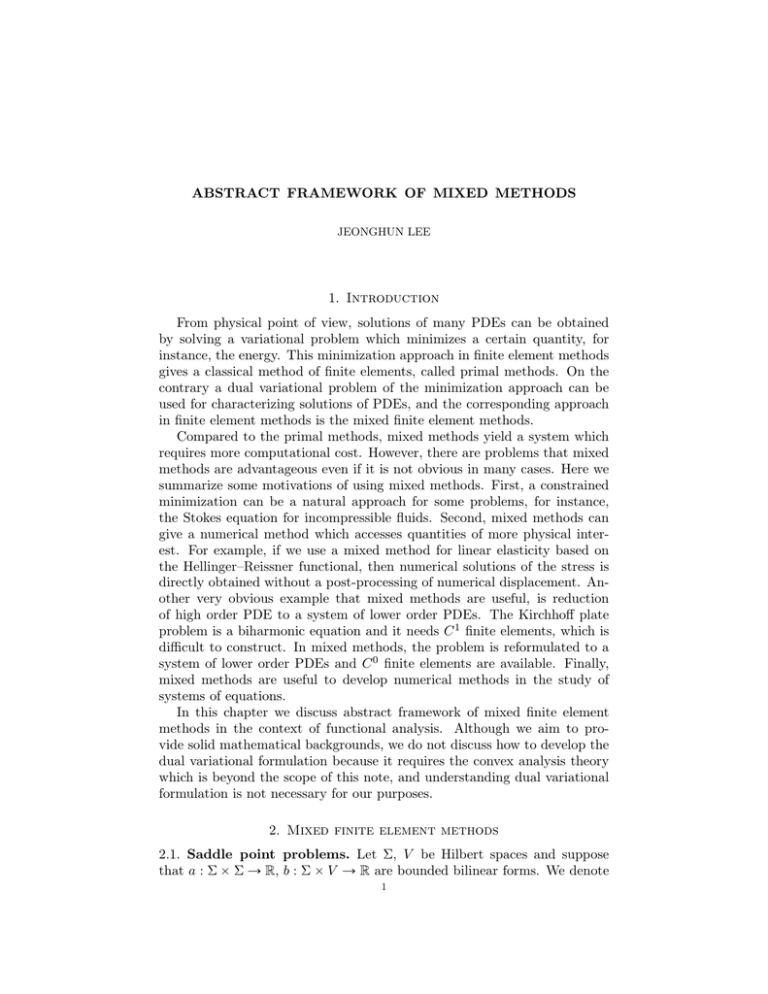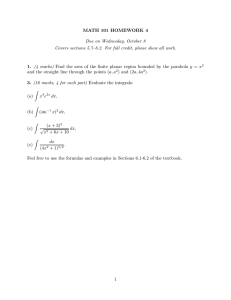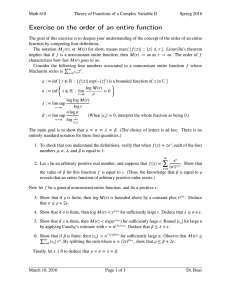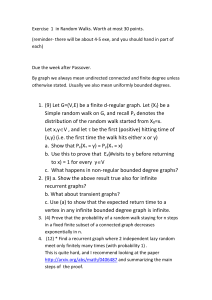ABSTRACT FRAMEWORK OF MIXED METHODS 1. Introduction
advertisement

ABSTRACT FRAMEWORK OF MIXED METHODS
JEONGHUN LEE
1. Introduction
From physical point of view, solutions of many PDEs can be obtained
by solving a variational problem which minimizes a certain quantity, for
instance, the energy. This minimization approach in finite element methods
gives a classical method of finite elements, called primal methods. On the
contrary a dual variational problem of the minimization approach can be
used for characterizing solutions of PDEs, and the corresponding approach
in finite element methods is the mixed finite element methods.
Compared to the primal methods, mixed methods yield a system which
requires more computational cost. However, there are problems that mixed
methods are advantageous even if it is not obvious in many cases. Here we
summarize some motivations of using mixed methods. First, a constrained
minimization can be a natural approach for some problems, for instance,
the Stokes equation for incompressible fluids. Second, mixed methods can
give a numerical method which accesses quantities of more physical interest. For example, if we use a mixed method for linear elasticity based on
the Hellinger–Reissner functional, then numerical solutions of the stress is
directly obtained without a post-processing of numerical displacement. Another very obvious example that mixed methods are useful, is reduction
of high order PDE to a system of lower order PDEs. The Kirchhoff plate
problem is a biharmonic equation and it needs C 1 finite elements, which is
difficult to construct. In mixed methods, the problem is reformulated to a
system of lower order PDEs and C 0 finite elements are available. Finally,
mixed methods are useful to develop numerical methods in the study of
systems of equations.
In this chapter we discuss abstract framework of mixed finite element
methods in the context of functional analysis. Although we aim to provide solid mathematical backgrounds, we do not discuss how to develop the
dual variational formulation because it requires the convex analysis theory
which is beyond the scope of this note, and understanding dual variational
formulation is not necessary for our purposes.
2. Mixed finite element methods
2.1. Saddle point problems. Let Σ, V be Hilbert spaces and suppose
that a : Σ Σ Ñ R, b : Σ V Ñ R are bounded bilinear forms. We denote
1
2
JEONGHUN LEE
the dual spaces of Σ, V by Σ , V . We now consider a variational problem
with constraints.
Constrained minimization problem. For F P Σ , G P V , find σ P Σ
which minimizes
1
J pσ q apσ, σ q F pσ q,
2
subject to the constraint bpσ, v q Gpv q for all v P V .
Instead of this minimization problem, we find a critical point pσ, uq P
Σ V of the functional
1
(1)
Lpτ, v q apτ, τ q bpτ, v q F pτ q Gpv q,
pτ, vq P Σ V,
2
by using the Lagrange multiplier u. By the variational methods, it is not
difficult to see that a critical point pσ, uq of (1) should satisfy
apσ, τ q
(2)
bpτ, uq F pτ q,
P Σ,
bpσ, v q Gpv q, v P V.
τ
Note that for any pτ, v q P Σ V , the inequalities
Lpσ, v q ¤ Lpσ, uq ¤ Lpτ, uq,
hold, so the variational problem of (1) is called a saddle point problem.
We will discuss necessary and sufficient conditions for the well-posedness
of problem (2). Define A : Σ Ñ Σ , B : Σ Ñ V by
(3)
pAσqpτ q apσ, τ q, pBσqpvq bpσ, vq,
Then we can rewrite (2) as
(4)
A B
B 0
τ
P Σ, v P V.
σ
u
F
.
G
In order to show well-posedness of (2), let
(5)
Z
tτ P Σ | bpτ, vq pBτ qpvq 0, @v P V u,
which is the null space of B. Since Z is a closed subspace of Σ, we have the
orthogonal decomposition Σ Z Z K , and we may consider the associated
decomposition Σ Z pZ K q . Let πZ , πZ K be the (orthogonal) projections from Σ onto Z , pZ K q , and define AZZ : Z Ñ Z , AZ K : Z Ñ pZ K q ,
AKZ : Z K Ñ Z , AKK : Z K Ñ pZ K q by
Aq|Z K ,
AKK : pπZ K Aq|Z K .
Recall that Z is the kernel of the operator B, so B |Z 0. Let
(7)
BK : B |Z K .
(6)
AZZ : πZ A|Z ,
AZ K : pπZ K Aq|Z K ,
AKZ : pπZ It is obvious that BK is injective.
In Banach space thery, a linear map is called isomorphic if it is bounded,
invertible, and its inverse is also bounded.
ABSTRACT FRAMEWORK OF MIXED METHODS
3
Theorem 1. Suppose that AZZ in (6) and BK , the restriction of B on Z K ,
are isomorphic. Then (2) has a unique solution pσ, uq P Σ V and there
exists c ¡ 0 such that
}σ}Σ }u}V ¤ cp}F }Σ }G}V q.
Proof. In order to prove the theorem, we consider the matrix form (4). We
define FZ , FK by the Z and pZ K q components of F in Σ . Then we rewrite
(4) as
AZZ
AK Z
0
AZ K 0
FZ
σZ
σK FK .
AKK BK
G
BK
0
u
We may regard the above matrix equation as the system of three equations.
If we interchange the first and second equations and rewrite it, then we have
AK Z
AZZ
0
AKK BK
σZ
FK
AZ K 0
σK FZ .
BK
0
u
G
After reordering unknowns, we have a matrix equation in the following which
is equivalent to the above one.
B
0K
0
AZ K AKK
u
FK
AZZ AKZ
σZ FZ .
0
BK
σK
G
are isomorphic, the coefficient matrix of the above matrix
Since AZZ , BK , BK
equation is invertible because it is a form of block upper triangular matrix
and all submatrices on diagonal entries are invertible. Thus a solution pσ, uq
of (2) exists uniquely. By direct computation, σ and u can be explicitly
written in terms of F , G, and bounded linear operators.
In the above theorem, the two conditions that AZZ and BK are isomorphic, are called the first and second Brezzi conditions, or Ladyazhenskaya–
Babus̆ka–Brezzi (LBB) conditions.
It is worth to know forms of the LBB conditions in terms of the operators a and b. In most practical applications, the following reduced LBB
conditions are sufficient.
(LBB1) There exists α ¡ 0 such that
(8)
apτ, τ q ¥ α}τ }2Σ ,
τ
P Z.
¡ 0 such that
bpτ, v q
¥ β ¡ 0.
inf sup
0v PV 0τ PΣ }τ }Σ }v }V
(LBB2) There exists β
(9)
These conditions are called the Z-coercivity condition and the inf-sup condition, respectively. By the Lax–Milgram lemma it is not difficult to see
that the Z-coercivity condition implies that AZZ is isomorphic. To see that
4
JEONGHUN LEE
the inf-sup condition yields that BK is isomorphic, we need a lemma in
functional analysis.
Lemma 1. Let X, Y be Hilbert spaces and B be a bounded bilinear form on
X Y . If we consider a linear map L : X Ñ Y defined by pLpxqqpy q :
B px, y q for x P X, y P Y , then L is isomorphic if
1. There exists β ¡ 0 such that
(10)
inf sup
2. For every y
PY
P
P
x Xy Y
B px, y q
}x}X }y}Y
¥ β.
there exists x P X such that B px, y q 0.
Proof. It is easy to see that L is bounded because B is bounded. By (10),
for x P X with }x}X 1,
}Lpxq}Y suppLpxqqpyq sup Bpx, yq ¥ β }y}Y ,
P
y Y
P
y Y
so L is injective and gives a bijection between X and LpX q. Furthermore,
the above inequality implies that L1 is bounded with }L1 }LpX qÑX ¤ 1{β.
Now we want to show that LpX q Y . We first claim that LpX q is closed
in Y . To see it, suppose that tfm u is a Cauchy sequence in LpX q with
fm Lpxm q, xm P X, and limmÑ8 fm f P Y . Since L1 on LpX q is
bounded, txm u is also a Cauchy sequence in X and has a limit x P X. Since
L is continuous
mlim
Ñ8 fm mlim
Ñ8 Lpxm q Lpmlim
Ñ8 xm q Lpxq.
Thus f P LpX q and LpX q is closed. Applying the Hahn–Banach theorem
with the standard identification Y Y of Hilbert spaces, there exists
y0 P Y such that
y0 pLpxqq 0, @x P X,
}y0}Y 1.
However, it contradicts to the second assumption of B because B px, y0 q 0
for any x P X. Thus LpX q Y .
f
Now we claim that the second LBB condition follows from the inf-sup
condition.
are
Theorem 2. For b and BK in the saddle point problem, BK and BK
isomorphisms if (9) holds.
pvqqpτ q bpτ, vq for τ P Z K , v P V . To apply TheProof. Recall that pBK
orem 1 to BK , it suffices to check that for any τ P Z K , there exists v P V
such that bpτ, v q 0. In fact, it is obvious by definition of Z. By Theorem
is an isomorphism. A standard argument will show that BK is an
1 BK
isomorphism, so we omit details.
Remark 1. In fact, the inf-sup condition and the second LBB condition are
equivalent but we proved only one direction for simplicity.
ABSTRACT FRAMEWORK OF MIXED METHODS
5
2.2. Stable mixed finite elements and error estimates. We consider
numerical solutions of the saddle point problem. Since the bilinear form a
is symmetric in most important problems, we assume that a is symmetric
for simplicity.
In order to solve the saddle point problem numerically with finite elements, we use finite element spaces Σh Σ, Vh V and consider the
following discrete form of problem (2): Find pσh , uh q P Σh Vh such that
a pσ h , τ q
P Σh ,
bpσh , v q Gpv q, v P Vh .
The pair of finite element spaces pΣh , Vh q is called a mixed finite element
(11)
bpτ, uh q F pτ q,
τ
and the numerical methods of solving the discrete saddle point problem
(11) with mixed finite elements are called mixed finite element methods or
mixed methods.
We consider the conditions that the problem (11) is well-posed. If we
apply Theorem 1 to (11), then we can derive the first and second LBB
conditions for pΣh , Vh q. As in the continuous saddle point problem, let
(12)
Zh
tτ P Σh | bpτ, vq 0,
v
P V h u,
and the discrete LBB conditions are
(LBB1) There exists αh ¡ 0 such that
apτ, τ q ¥ αh }τ }2Σ ,
(13)
τ
P Zh .
¡ 0 such that
bpτ, v q
¥ βh ¡ 0.
inf
sup
0v PV 0τ PΣ }τ }Σ }v }V
(LBB2) There exists β
(14)
h
h
Note that these conditions for well-posedness are valid only for a specific
pair pΣh , Vh q. To have a robust numerical method let us consider a family
of mixed finite elements tpΣh , Vh quh¡0 with mesh size parameter h satisfying
(13) and (14). Then tpΣh , Vh quh¡0 is called stable if αh , βh are bounded below by some positive constants, say α , β , independent of h. For simplicity,
we use pΣh , Vh q to denote the family of finite elements tpΣh , Vh quh¡0 .
Theorem 3. Suppose that pΣh , Vh q is a stable mixed finite element. Then
the following error estimate holds.
(15)
}σ σh}Σ
}u uh}V ¤
Proof. Let σ̃h P Σh , ũh
(2) and (11) gives
apσ σh , τ q
c
inf }σ τ }Σ
P
τ Σh
P Vh which will be chosen later.
bpτ, u uh q
bpσ σh , v q 0,
inf }u v }V
P
v Vh
.
The difference of
pτ, vq P Σh Vh.
6
JEONGHUN LEE
This is equivalent to
(16) apσh σ̃h , τ q
bpτ, uh ũh q
bpσh σ̃h , v q
apσ σ̃h, τ q
bpτ, u ũh q
bpσ σ̃h , v q.
By the LBB stability of the saddle point problem and by (16), there exists
pτ, vq P Σh Vh such that }τ }Σ }v}V ¤ C, and
}σh σ̃h}Σ }uh ũh}V
¤ apσh σ̃h, τ q bpτ, uh ũhq bpσh σ̃h, vq
apσ σ̃h, τ q bpτ, u ũhq bpσ σ̃h, vq
¤ cp}σ σ̃h}Σ }u ũh}V q,
where the last inequality is due to continuity of the bilinear forms a and b.
By the triangle inequality and the above result, we have
}σ σh}Σ }u uh}V
¤ }σ σ̃h}Σ }σ̃h σh}Σ }u ũh}V }ũh uh}V
¤ cp}σ σ̃h}Σ }u ũh}V q.
Since σ̃h P Σh , ũh P Vh are arbitrary, the assertion follows by choosing them
to be the best approximations of σ and u in Σh and Vh , respectively.
As in the continuous case the first Brezzi condition can be replaced by a
coercivity condition
apτ, τ q ¥ c}τ }2Σh ,
(17)
@τ P Zh.
2.3. Stability criterion via Fortin operators.
Theorem 4. Suppose that the (continuous) inf-sup condition holds. Then
the discrete inf-sup condition holds with a constant independent of h if and
only if there exists an operator Πh : Σ Ñ Σh such that, for any τ P Σ,
bpτ
Πhτ, vq 0, @v P Vh,
with a constant C ¡ 0 independent of h.
}Πhτ }Σ ¤ C }τ }Σ,
Proof. Suppose that such an operator Πh exists. Then, for any v
β }v }V
¤ sup b}pττ,}vq sup bpΠ}τh}τ, vq ¤ C sup b}pΠΠhττ,}vq ,
P
τ Σ
Σ
P
τ Σ
Σ
P
h
τ Σ
Σ
P Vh,
so the discrete inf-sup condition holds with βh β {C.
Conversely, suppose that the discrete inf-sup condition holds with some
β ¡ 0 independent of h. Since the discrete saddle point problem is wellposed, for σ P Σ, we may consider the problem
a pσ h , τ q
bpτ, uh q apσ, τ q,
bpσh , v q bpσ, v q,
P Σh,
v P Vh .
τ
ABSTRACT FRAMEWORK OF MIXED METHODS
7
Now we define Πh σ as σh . Then the second equation of the above yields
bpσ Πh σ, v q 0 for all v P Vh . To see that Πh : Σ Ñ Σh is bounded, we
first note that
}σ Πhσh}Σ }σ Πhσ}Σ ¤ c}σ}Σ,
by (15) with u v τ 0. By the triangle inequality
}Πhσ}Σ ¤ }Πhσ σ}Σ }σ}Σ ¤ c}σ}Σ,
so the assertion holds.
Last updated : 2013, September 10.




![Student number Name [SURNAME(S), Givenname(s)] MATH 101, Section 212 (CSP)](http://s2.studylib.net/store/data/011174923_1-a1ea9166f1b13a776f191eec410dcac0-300x300.png)

